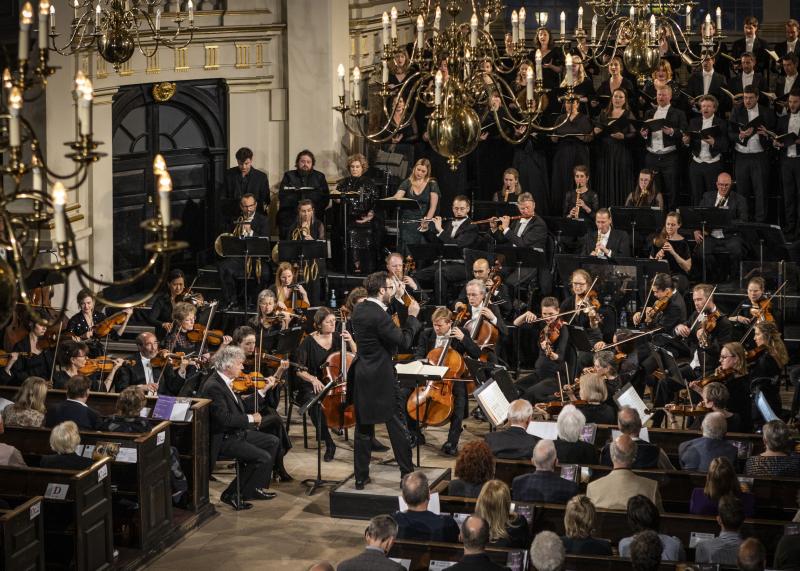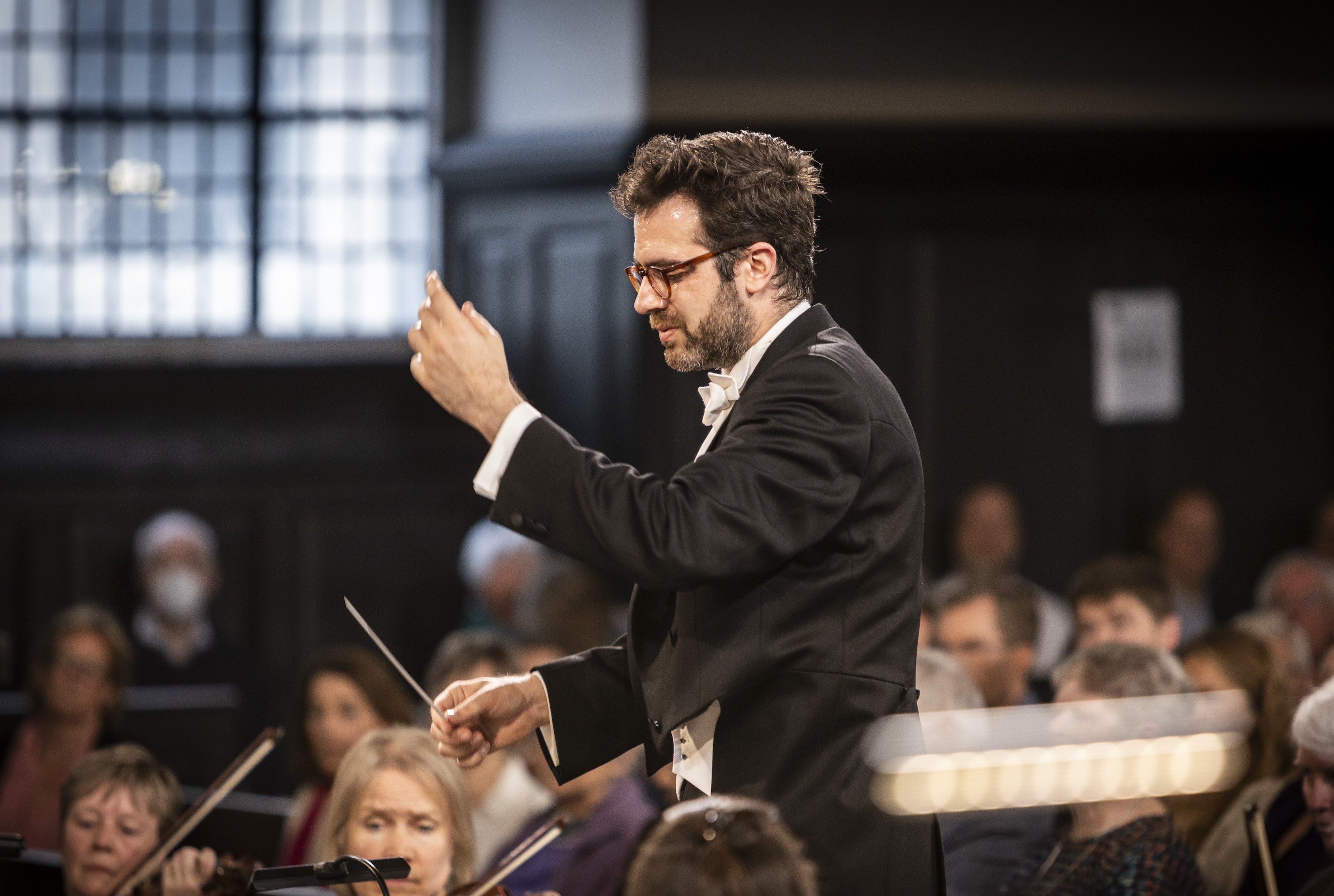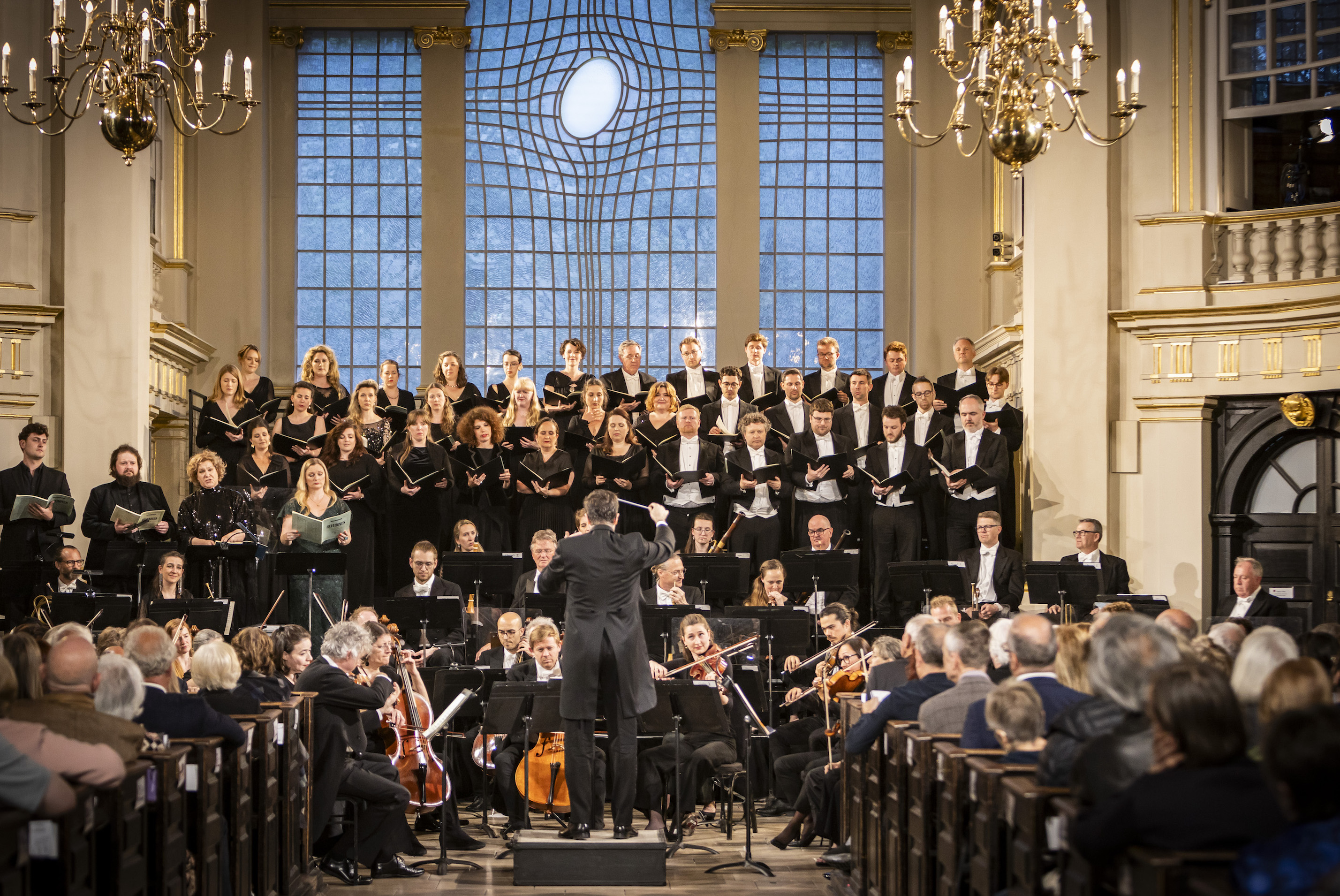Orchestre Révolutionnaire et Romantique, Sousa, St Martin-in-the-Fields review - Beethoven, younger than springtime | reviews, news & interviews
Orchestre Révolutionnaire et Romantique, Sousa, St Martin-in-the-Fields review - Beethoven, younger than springtime
Orchestre Révolutionnaire et Romantique, Sousa, St Martin-in-the-Fields review - Beethoven, younger than springtime
An exuberant cobweb-clearing symphony cycle

Better (much better, indeed) late than never. The Orchestre Révolutionnaire et Romantique should have given their cycle of Beethoven symphonies at St Martin-in-the-Fields in May 2020, after touring to Spain and the US. A lot has happened since. The pandemic scuppered the original timetable, while his own alleged actions – after he reportedly attacked a singer during rehearsals in France last year – have kept the ORR’s founder John Eliot Gardiner off the podium.
So last week the period-instrument ensemble arrived at St Martin’s under the baton of Portuguese wunderkind Dinis Sousa. I caught the final two evenings – covering symphonies Six to Nine – of the cycle, and on that evidence can affirm that Beethoven has (as always) soared triumphantly above whatever fate can throw at him. Sousa and the ORR (supported in the Ninth by the Monteverdi Choir and a stellar quartet of soloists) delivered performances of radiant intensity and commitment, filling the relatively small space of the church with an electric crackle of excitement tempered by virtuosic swagger and – not least – infectious fun.
The ORR period sound – mellow, woody, balanced but never insipid – suits the venue perfectly. Though this mid-sized outfit can hardly be classified as a “chamber” ensemble, Sousa’s handling did bring the elements of nimble, classical elegance to the fore: in a very Haydn-esque Eighth above all. Yet the ferocious dance-driven momentum of the Seventh, or the jubilant fullness of the climax of the Ninth, banished any apprehension that we would have to make do with over-polite salon Beethoven stripped of his ardour and fury. Sousa (pictured above) kept his tempi brisk, and textures clean, with a well-judged dynamic range that never overwhelmed the limited space – except, forgivably, as the final Ode to Joy erupted. You expect fierce pace and pulse from the ORR but Sousa never comes over as a rigid metronomic bustler. He does specialise in spectacular whipcrack entries, right arm violently flung towards the band, so that you fear he might take off and land somewhere deep in the woods. He bounces, indeed leaps, around the podium with compelling agility but tempers these acrobatics with fluid gestures that bring forth some lovely legato passages. He can stroke as well as punch. Attention to instrumental detail impresses at every turn as the burnished blend of the ORR sonorities makes room – from the velvety warmth of the strings led by Peter Hanson to the bubbling charm of clarinets (Nicola Boud, Fiona Mitchell) and the thrilling crack of Robert Kendell’s timpani – for robust, precise sectional voices.
Sousa (pictured above) kept his tempi brisk, and textures clean, with a well-judged dynamic range that never overwhelmed the limited space – except, forgivably, as the final Ode to Joy erupted. You expect fierce pace and pulse from the ORR but Sousa never comes over as a rigid metronomic bustler. He does specialise in spectacular whipcrack entries, right arm violently flung towards the band, so that you fear he might take off and land somewhere deep in the woods. He bounces, indeed leaps, around the podium with compelling agility but tempers these acrobatics with fluid gestures that bring forth some lovely legato passages. He can stroke as well as punch. Attention to instrumental detail impresses at every turn as the burnished blend of the ORR sonorities makes room – from the velvety warmth of the strings led by Peter Hanson to the bubbling charm of clarinets (Nicola Boud, Fiona Mitchell) and the thrilling crack of Robert Kendell’s timpani – for robust, precise sectional voices.
The two symphonic pairings I heard (Sixth with Seventh, then Eighth with Ninth) illuminated not just obvious contrasts but ear-opening continuities. Sousa, for instance, made you hear that, in the sizzling martial finale of the Seventh, the tipsy lurching pre-storm peasants of the Sixth have sobered up and gone to war. Overall, Sousa’s Pastoral landscape boasted more elegance than rusticity. The ORR felt often like a sophisticated wind band in dialogue with an equally polished, but never languid, string ensemble. Here, as over both evenings, the principal woodwinds consistently shone – Boud’s clarinet, Catriona McDermid’s bassoon, Michael Niesemann’s oboe, Marten Root’s flute – supported by accomplished partners. Period timbres entailed no sacrifice of power.
For the brass, perhaps, not quite the same can be said: of course, they have little to do for long stretches of these symphonies, though from the Sixth onwards Anneke Scott and the other horns added delicate and flavourful shadings to the mix. Still, they sometimes sounded over-modest while their neighbours sang out strongly. But, as if making up for their previous absences, the brass of the Ninth truly dazzled, with trombones and trumpets gloriously in excelsis as the finale unfolded.
If the woodwind bird-calls of the Sixth sounded more refined than bucolic, the slurring country dance had a spit-and-sawdust drive before a thunderous storm. Sousa manages transitions well; the shepherds’ hymn at first avoided undue sentiment but, with gradually added fervour, its final iteration filled the church with enveloping warmth. The Seventh showcased Sousa’s flair for sudden attack, with knife-sharp entries and fortissimo dramatic coups. Always crisp, but never provocatively harsh, Sousa’s approach paid handsome dividends in an Allegretto that tempered relentless menace with smooth, broad phrasing that enhanced its power. Sousa knows how to balance force with grace: the rhythmic push of the Seventh’s last two movements allowed for elasticity in tempi that stopped it from feeling like a bullying forced march.  The cycle’s final evening spotlit the sheer variety of mood and tone encompassed in the the ORR soundscape. Skipping, droll, polished, the Eighth had a courtly elegance and wit adorned at first by solo flourishes from flute and bassoon. Sousa masterminded the deft, sharp conversazione between voices as the symphony ticked on through its disconcerting clock-like allegretto and into the minuet (with solo horn and clarinet deliciously to the fore). But the ORR style, with its boldly outlined clarity and contrast, also suits the sheer harmonic radicalism of the finale, as its brazen “wrong” notes from distant keys suddenly shift the musical route. If this is the Beethoven symphony that can make orthodox big bands sound leaden or galumphing, Sousa expertly nailed its deviously transgressive charm.
The cycle’s final evening spotlit the sheer variety of mood and tone encompassed in the the ORR soundscape. Skipping, droll, polished, the Eighth had a courtly elegance and wit adorned at first by solo flourishes from flute and bassoon. Sousa masterminded the deft, sharp conversazione between voices as the symphony ticked on through its disconcerting clock-like allegretto and into the minuet (with solo horn and clarinet deliciously to the fore). But the ORR style, with its boldly outlined clarity and contrast, also suits the sheer harmonic radicalism of the finale, as its brazen “wrong” notes from distant keys suddenly shift the musical route. If this is the Beethoven symphony that can make orthodox big bands sound leaden or galumphing, Sousa expertly nailed its deviously transgressive charm.
Conversely, you feared that the unleashed passions of the Ninth might lie beyond their reach. No need to worry: Sousa gave the ORR sound an (almost) traditional makeover, and never stunted on old-school grandeur in the majestic tutti or solemn marches of the opening movement. Never a speed-merchant for the sake of pace alone, he reined in tempi to respect the “maestoso” marking. Tender woods showed us the vulnerable humanity that sets out on the symphony’s epic voyage. After a shattering climax, the hammering fugato of the scherzo had a sinister edge to its jubilant onrush: demonic and playful all at once.
If the country-style lilt and swing of the woods in the trio took us back to the Sixth, the swooping lushness of the string textures Sousa drew from the ORR in the cantabile adagio heralded another sort of musical galaxy entirely. An outfit that, before the interval, had tipped its smart tricorn hat to Haydn now waved forwards on swooning strings towards the yearning, anguished world of Mahler. Flute, clarinet and a fine horn solo joined no-longer-shy brass and Kendell’s emphatic timpani to prepare the way for the advent of the choir.  Robin Michael’s cellos introduced the main theme with satisfying bite before the young bass William Thomas shook the air with his call for more joyful sounds. Absolutely assured, warm and firm in tone, Thomas’s riveting intervention ushered in strong work from the starry trio beside him (pictured above) – Allan Clayton’s tenor, Lucy Crowe’s soprano, Alice Coote’s mezzo – but was never eclipsed by them.
Robin Michael’s cellos introduced the main theme with satisfying bite before the young bass William Thomas shook the air with his call for more joyful sounds. Absolutely assured, warm and firm in tone, Thomas’s riveting intervention ushered in strong work from the starry trio beside him (pictured above) – Allan Clayton’s tenor, Lucy Crowe’s soprano, Alice Coote’s mezzo – but was never eclipsed by them.
The Monteverdi Choir, meanwhile, powered through the Ode to Joy variations with a disciplined wildness that never left space for a smug or sedate bar. Sousa found a sort of savage innocence in their mighty outburst as the St Martin’s acoustic lent this controlled violence a near-scary immediacy and brilliance. Even amid this wall-shaking explosion of ecstasy, though, the soloists’ quartet transmitted the blended exultation of the Ode with the festive panache of a Mozartian operatic finale. As throughout the ORR performances, Sousa let us hear Beethoven moving between past and future: revolutionary, romantic but contemporary too. As the Ninth confirmed, the taut energy, freshness and finesse of his direction and the ORR's playing yield not some lightweight pastel sketch but a revivifying brightness and lustre in all departments. In the end these most familiar figures from the classical repertoire sounded, as they should, forever young.
rating
Explore topics
Share this article
The future of Arts Journalism
You can stop theartsdesk.com closing!
We urgently need financing to survive. Our fundraising drive has thus far raised £49,000 but we need to reach £100,000 or we will be forced to close. Please contribute here: https://gofund.me/c3f6033d
And if you can forward this information to anyone who might assist, we’d be grateful.

Subscribe to theartsdesk.com
Thank you for continuing to read our work on theartsdesk.com. For unlimited access to every article in its entirety, including our archive of more than 15,000 pieces, we're asking for £5 per month or £40 per year. We feel it's a very good deal, and hope you do too.
To take a subscription now simply click here.
And if you're looking for that extra gift for a friend or family member, why not treat them to a theartsdesk.com gift subscription?
more Classical music
 First Person: clarinettist Oliver Pashley on the new horizons of The Hermes Experiment's latest album
Compositions by members of this unusual quartet feature for the first time
First Person: clarinettist Oliver Pashley on the new horizons of The Hermes Experiment's latest album
Compositions by members of this unusual quartet feature for the first time
 Gesualdo Passione, Les Arts Florissants, Amala Dior Company, Barbican review - inspired collaboration excavates the music's humanity
At times it was like watching an anarchic religious procession
Gesualdo Passione, Les Arts Florissants, Amala Dior Company, Barbican review - inspired collaboration excavates the music's humanity
At times it was like watching an anarchic religious procession
 Classical CDs: Camels, concrete and cabaret
An influential American composer's 90th birthday box, plus British piano concertos and a father-and-son duo
Classical CDs: Camels, concrete and cabaret
An influential American composer's 90th birthday box, plus British piano concertos and a father-and-son duo
 Cockerham, Manchester Camerata, Sheen, Martin Harris Centre, Manchester review - re-enacting the dawn of modernism
Two UK premieres added to three miniatures from a seminal event of January 1914
Cockerham, Manchester Camerata, Sheen, Martin Harris Centre, Manchester review - re-enacting the dawn of modernism
Two UK premieres added to three miniatures from a seminal event of January 1914
 Kempf, Brno Philharmonic, Davies, Bridgewater Hall, Manchester review - European tradition meets American jazz
Bouncing Czechs enjoy their Gershwin and Brubeck alongside Janáček and Dvořák
Kempf, Brno Philharmonic, Davies, Bridgewater Hall, Manchester review - European tradition meets American jazz
Bouncing Czechs enjoy their Gershwin and Brubeck alongside Janáček and Dvořák
 Solomon, OAE, Butt, QEH review - daft Biblical whitewashing with great choruses
Even a top soprano and mezzo can’t make this Handel paean wholly convincing
Solomon, OAE, Butt, QEH review - daft Biblical whitewashing with great choruses
Even a top soprano and mezzo can’t make this Handel paean wholly convincing
 Two-Piano Gala, Kings Place review - shining constellations
London Piano Festival curators and illustrious friends entertain and enlighten
Two-Piano Gala, Kings Place review - shining constellations
London Piano Festival curators and illustrious friends entertain and enlighten
 Echo Vocal Ensemble, Latto, Union Chapel review - eclectic choral programme garlanded with dance
Beautiful singing at the heart of an imaginative and stylistically varied concert
Echo Vocal Ensemble, Latto, Union Chapel review - eclectic choral programme garlanded with dance
Beautiful singing at the heart of an imaginative and stylistically varied concert
 Scott, Irish Baroque Orchestra, Whelan, RIAM, Dublin review - towards a Mozart masterpiece
Characteristic joy and enlightenment from this team, but a valveless horn brings problems
Scott, Irish Baroque Orchestra, Whelan, RIAM, Dublin review - towards a Mozart masterpiece
Characteristic joy and enlightenment from this team, but a valveless horn brings problems
 Classical CDs: Voice flutes, flugelhorns and froth
Baroque sonatas, English orchestral music and an emotionally-charged vocal recital
Classical CDs: Voice flutes, flugelhorns and froth
Baroque sonatas, English orchestral music and an emotionally-charged vocal recital
 Kanneh-Mason, Britten Sinfonia, Shave, Milton Court - a grin and a big beaming smile
A pair of striking contemporary pieces alongside two old favourites
Kanneh-Mason, Britten Sinfonia, Shave, Milton Court - a grin and a big beaming smile
A pair of striking contemporary pieces alongside two old favourites

Add comment